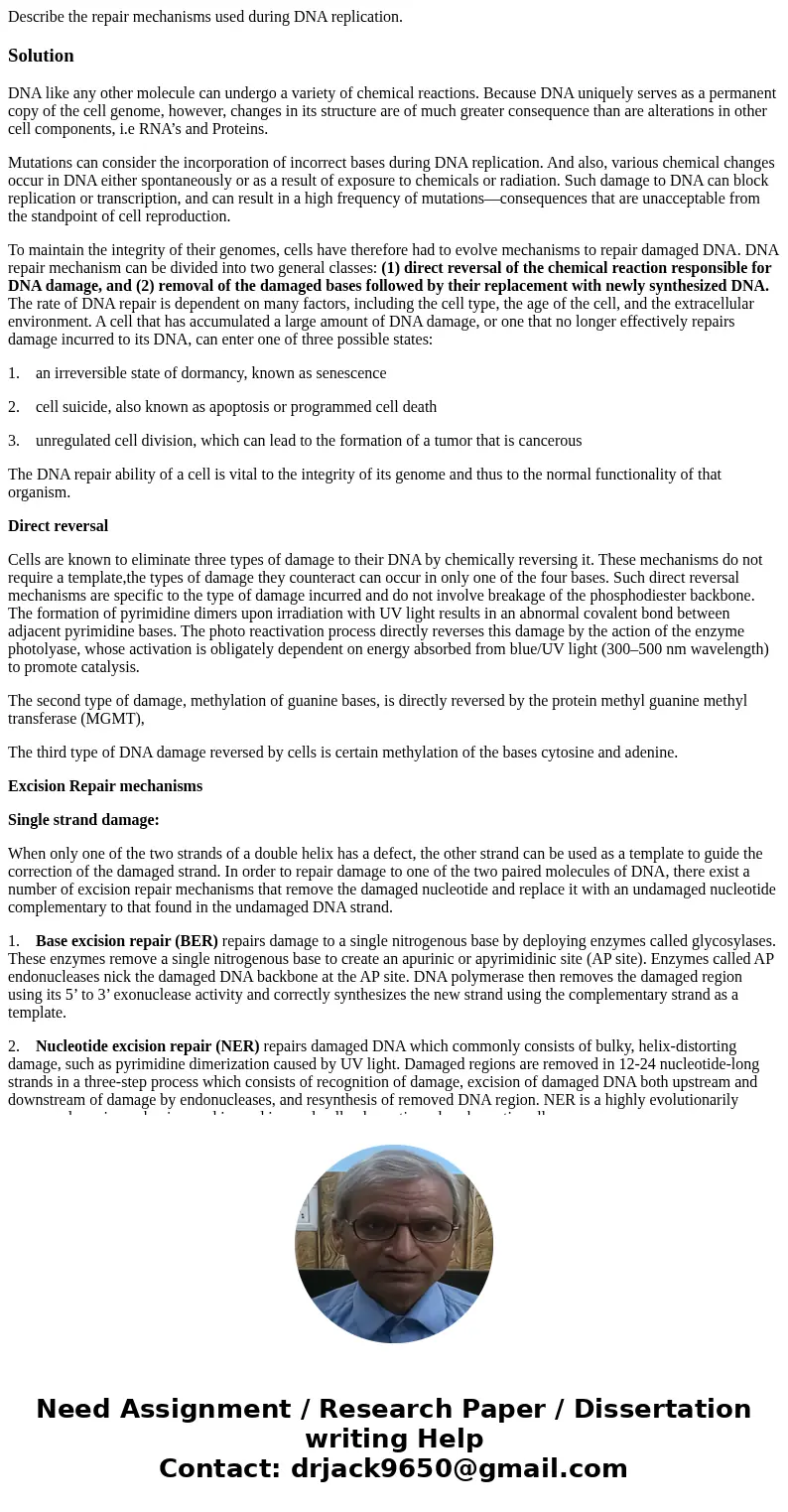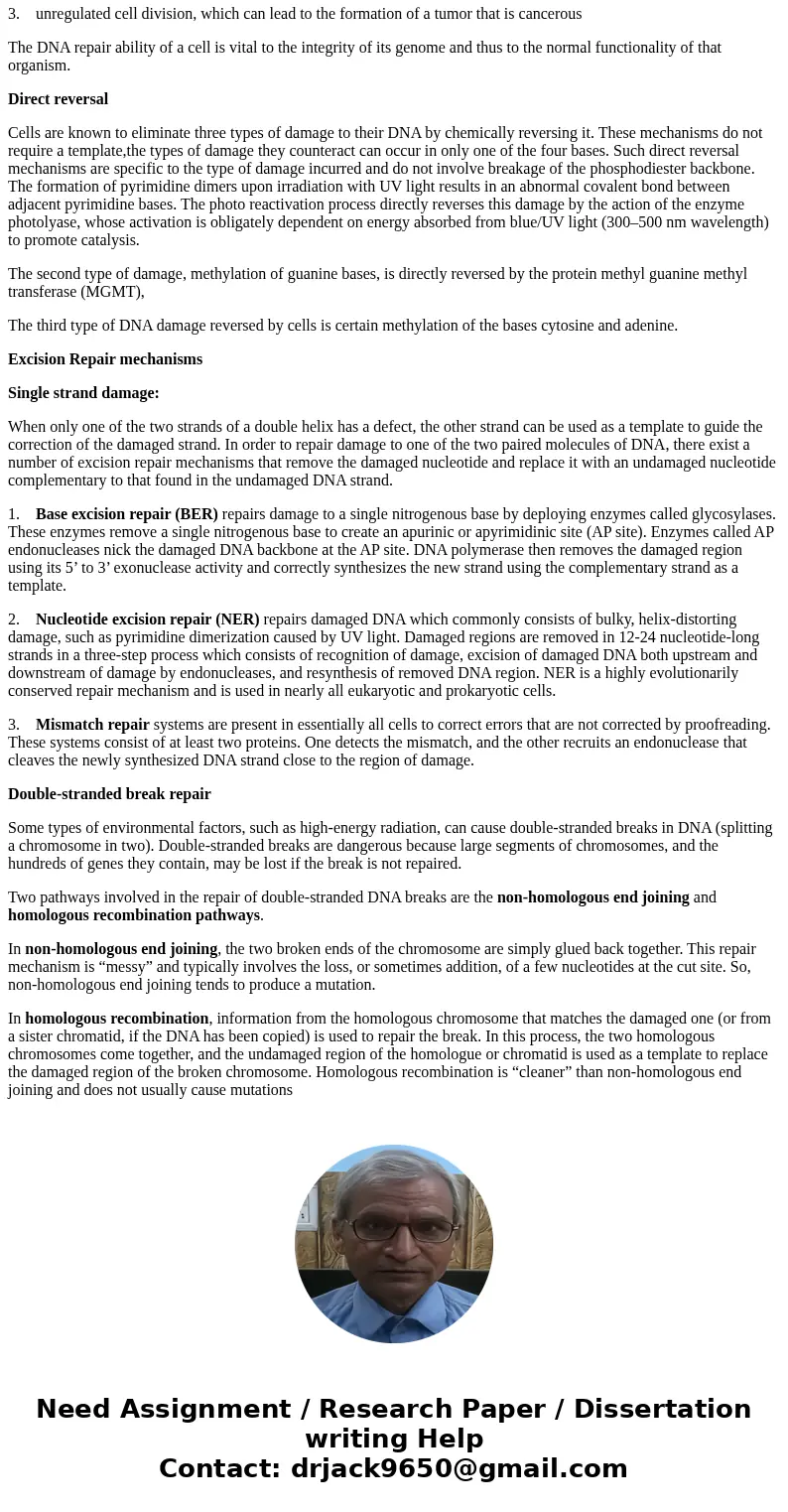Describe the repair mechanisms used during DNA replicationSo
Solution
DNA like any other molecule can undergo a variety of chemical reactions. Because DNA uniquely serves as a permanent copy of the cell genome, however, changes in its structure are of much greater consequence than are alterations in other cell components, i.e RNA’s and Proteins.
Mutations can consider the incorporation of incorrect bases during DNA replication. And also, various chemical changes occur in DNA either spontaneously or as a result of exposure to chemicals or radiation. Such damage to DNA can block replication or transcription, and can result in a high frequency of mutations—consequences that are unacceptable from the standpoint of cell reproduction.
To maintain the integrity of their genomes, cells have therefore had to evolve mechanisms to repair damaged DNA. DNA repair mechanism can be divided into two general classes: (1) direct reversal of the chemical reaction responsible for DNA damage, and (2) removal of the damaged bases followed by their replacement with newly synthesized DNA. The rate of DNA repair is dependent on many factors, including the cell type, the age of the cell, and the extracellular environment. A cell that has accumulated a large amount of DNA damage, or one that no longer effectively repairs damage incurred to its DNA, can enter one of three possible states:
1. an irreversible state of dormancy, known as senescence
2. cell suicide, also known as apoptosis or programmed cell death
3. unregulated cell division, which can lead to the formation of a tumor that is cancerous
The DNA repair ability of a cell is vital to the integrity of its genome and thus to the normal functionality of that organism.
Direct reversal
Cells are known to eliminate three types of damage to their DNA by chemically reversing it. These mechanisms do not require a template,the types of damage they counteract can occur in only one of the four bases. Such direct reversal mechanisms are specific to the type of damage incurred and do not involve breakage of the phosphodiester backbone. The formation of pyrimidine dimers upon irradiation with UV light results in an abnormal covalent bond between adjacent pyrimidine bases. The photo reactivation process directly reverses this damage by the action of the enzyme photolyase, whose activation is obligately dependent on energy absorbed from blue/UV light (300–500 nm wavelength) to promote catalysis.
The second type of damage, methylation of guanine bases, is directly reversed by the protein methyl guanine methyl transferase (MGMT),
The third type of DNA damage reversed by cells is certain methylation of the bases cytosine and adenine.
Excision Repair mechanisms
Single strand damage:
When only one of the two strands of a double helix has a defect, the other strand can be used as a template to guide the correction of the damaged strand. In order to repair damage to one of the two paired molecules of DNA, there exist a number of excision repair mechanisms that remove the damaged nucleotide and replace it with an undamaged nucleotide complementary to that found in the undamaged DNA strand.
1. Base excision repair (BER) repairs damage to a single nitrogenous base by deploying enzymes called glycosylases. These enzymes remove a single nitrogenous base to create an apurinic or apyrimidinic site (AP site). Enzymes called AP endonucleases nick the damaged DNA backbone at the AP site. DNA polymerase then removes the damaged region using its 5’ to 3’ exonuclease activity and correctly synthesizes the new strand using the complementary strand as a template.
2. Nucleotide excision repair (NER) repairs damaged DNA which commonly consists of bulky, helix-distorting damage, such as pyrimidine dimerization caused by UV light. Damaged regions are removed in 12-24 nucleotide-long strands in a three-step process which consists of recognition of damage, excision of damaged DNA both upstream and downstream of damage by endonucleases, and resynthesis of removed DNA region. NER is a highly evolutionarily conserved repair mechanism and is used in nearly all eukaryotic and prokaryotic cells.
3. Mismatch repair systems are present in essentially all cells to correct errors that are not corrected by proofreading. These systems consist of at least two proteins. One detects the mismatch, and the other recruits an endonuclease that cleaves the newly synthesized DNA strand close to the region of damage.
Double-stranded break repair
Some types of environmental factors, such as high-energy radiation, can cause double-stranded breaks in DNA (splitting a chromosome in two). Double-stranded breaks are dangerous because large segments of chromosomes, and the hundreds of genes they contain, may be lost if the break is not repaired.
Two pathways involved in the repair of double-stranded DNA breaks are the non-homologous end joining and homologous recombination pathways.
In non-homologous end joining, the two broken ends of the chromosome are simply glued back together. This repair mechanism is “messy” and typically involves the loss, or sometimes addition, of a few nucleotides at the cut site. So, non-homologous end joining tends to produce a mutation.
In homologous recombination, information from the homologous chromosome that matches the damaged one (or from a sister chromatid, if the DNA has been copied) is used to repair the break. In this process, the two homologous chromosomes come together, and the undamaged region of the homologue or chromatid is used as a template to replace the damaged region of the broken chromosome. Homologous recombination is “cleaner” than non-homologous end joining and does not usually cause mutations


 Homework Sourse
Homework Sourse